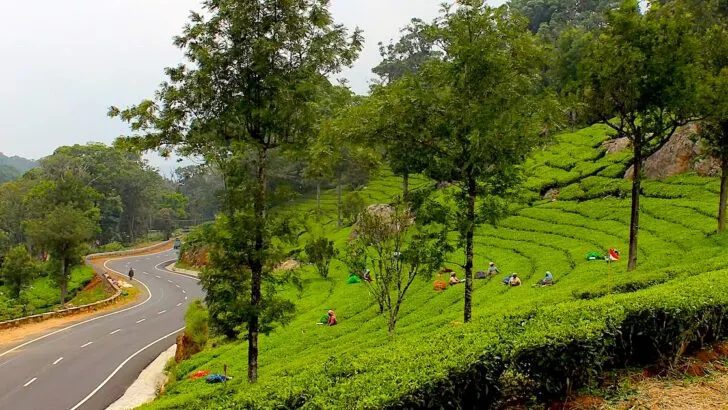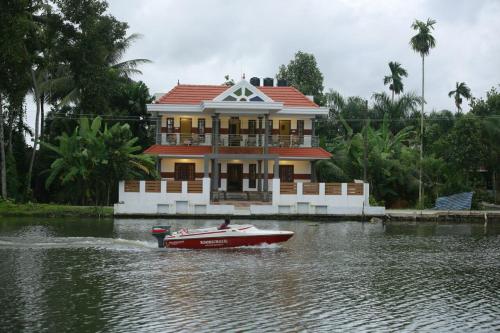I had so much fun planning and carrying out my Kerala itinerary. After visiting Goa one year prior, I was desperate to explore Kerala, India’s southernmost state.
There is a huge variety of things to do in Kerala, from houseboat cruises and visiting spice, coffee and tea plantations to getting traditional ayurveda treatments and watching Kathakali (one of Kerala’s many traditional art forms).
That’s not to mention the food: delicious seafood, coconut-based curries, tropical fruit and rice pancakes.
It’s no wonder that planning your Kerala itinerary can feel overwhelming.
I created this succinct Kerala travel guide to help you properly plan your trip (including the travel logistics and the best places to visit in Kerala).
While you’re here, you might also want to check out my guide to what to wear in Kerala.
Disclosure: This post includes affiliate links. If you decide to click through and make a qualifying purchase, I will receive a small commission at no extra cost to you – thanks for your support.
I created this post following a sponsored trip hosted by Kerala Tourism. They covered my hotel and travel costs and gave me many helpful pointers. I then continued my Kerala trip solo – all of the advice in this post is my own, so I hope you find it useful!
QUICK INFORMATION
Best time to visit: September to March
Best places to visit: Kochi, Munnar, Thekkady, Kannur, Wayanad, Kovalam
How to get there: Fly to Cochin
Where is Kerala?
Kerala is the southernmost state in India.
It’s just north of Sri Lanka and borders the Indian states of Tamil Nadu and Karnataka.
In north Kerala, you will find Wayanad, Kannur and Kozhikode. Wayanad is a famous highland area, popular for outdoor activities.
In central Kerala, you have the biggest concentration of tourist areas.
This includes the city of Kochi, Alleppey and Kumarakom (famous for their backwaters), Munnar (a highland area with tea plantations) and Thekkady (famous for wildlife and outdoor activities).
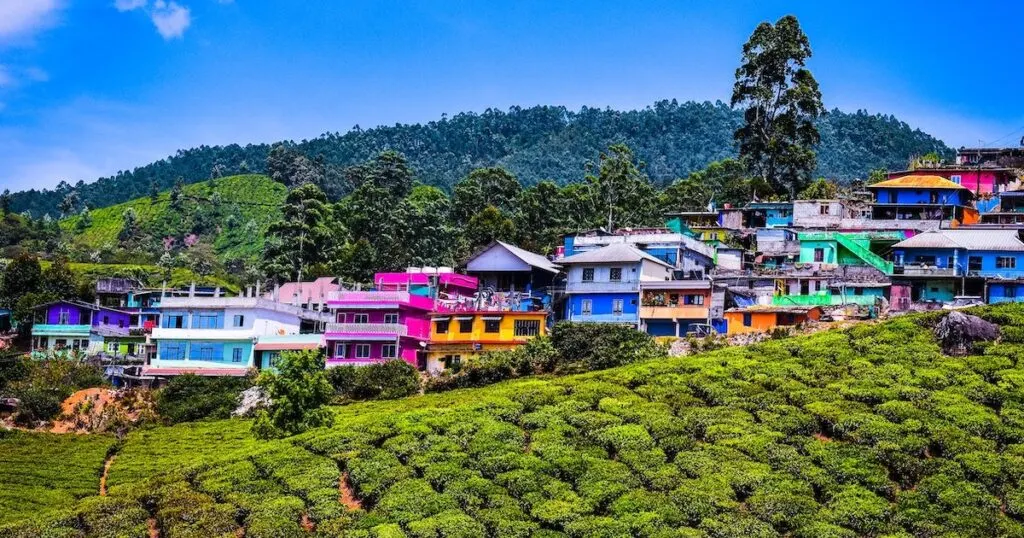
Munnar
South Kerala is best known for its beaches. Popular destinations include Trivandrum, Kovalam and Kollam.
Is Kerala Worth Visiting?
The best part about Kerala is that it has variety.
Most of the time, when someone asks me if they should travel to a specific destination, I must consider whether their travel style and personal interests fit with the destination.
However, I would wholeheartedly recommend visiting Kerala to anyone.
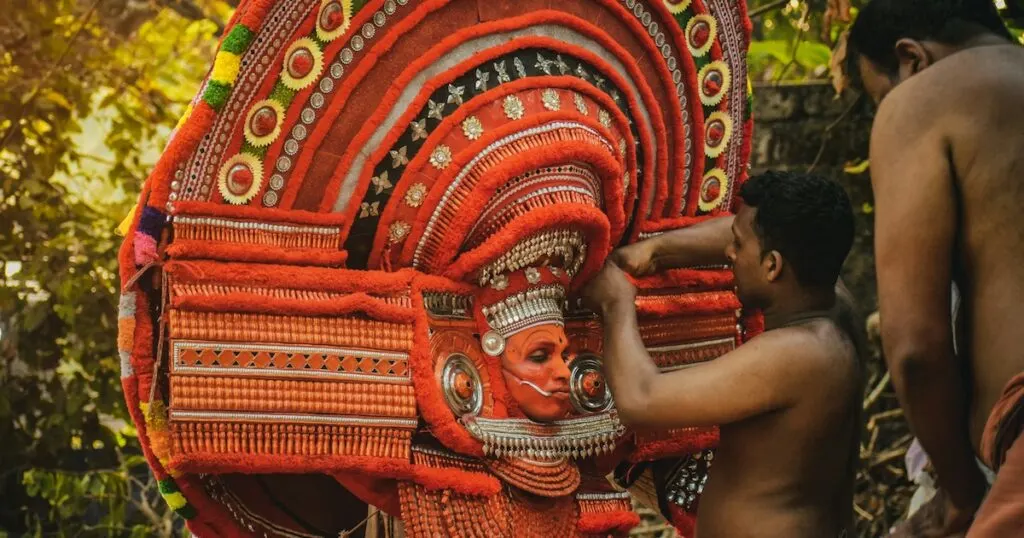
You can easily explore Kerala on a budget or in luxury.
In fact, the luxury resorts in Kerala are some of the best I’ve experienced (think backwater resorts, heritage hotels and Ayurveda resorts).
For the quality you receive, they are very cheap in comparison to the West.
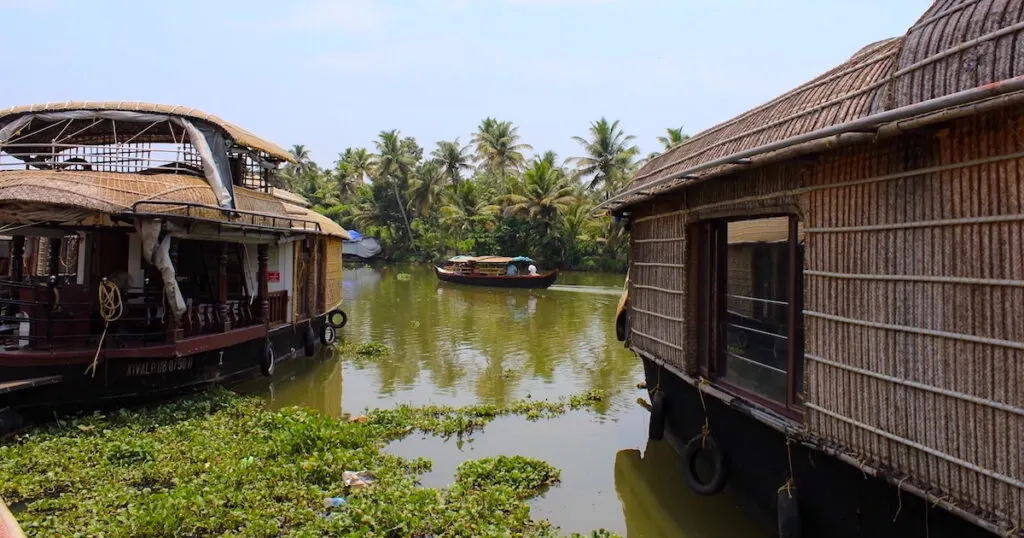
Kerala also has a mix of highlands, beaches and wildlife-rich backwaters.
There are places to do outdoor activities, have unique cultural experiences, visit temples and go on safaris.
Here is just a summary of things to do in Kerala:
- Backwater cruises and houseboat cruises.
- Outdoor activities, including hiking, rafting and cycling.
- Trying traditional Kerala food.
- Visiting temples and historic sites.
- Watching traditional art forms such as Kathakali.
- Visiting tea, spice and coffee plantations.
- Wildlife watching, including elephants, monkeys and Nilgiri tahr.
A Short History of Kerala
As Kerala is so rich in spices and highland areas suitable for growing tea leaves or coffee beans, it has been controlled by several colonial powers over the years.
Its early history is mostly ruled by the Kulashekhara dynasty. This explains why Malayalam is a common language spoken in Kerala. This is also how Hinduism came to be the prevalent religion.
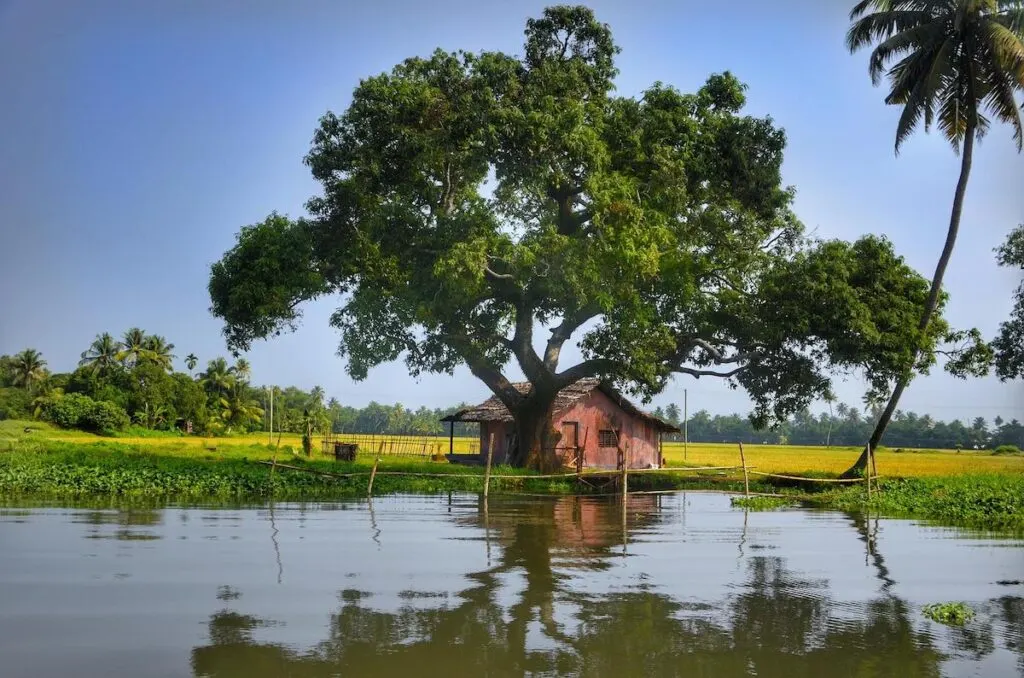
Arab traders had control of Kerala until 1498, which is when the Portuguese arrived.
By the 16th century, Portugal had control over Kerala and its trade routes.
However, their colonial rule was short-lived, as the Dutch arrived in the 17th century. For a brief period, the British took control of parts of Kerala too.
This is why you will see scatterings of British, Portuguese and Dutch colonial architecture around Kerala.
India declared independence in 1947.
How to Get to Kerala
There are four main airports in Kerala:
- Cochin – central Kerala
- Trivandrum – south Kerala
- Kozhikode – north Kerala
- Kannur – north Kerala
I flew into Cochin airport, after connecting in Delhi.
From the city, I travelled by van to Alleppey, Munnar and Thekkady (all within a few hours’ drive).
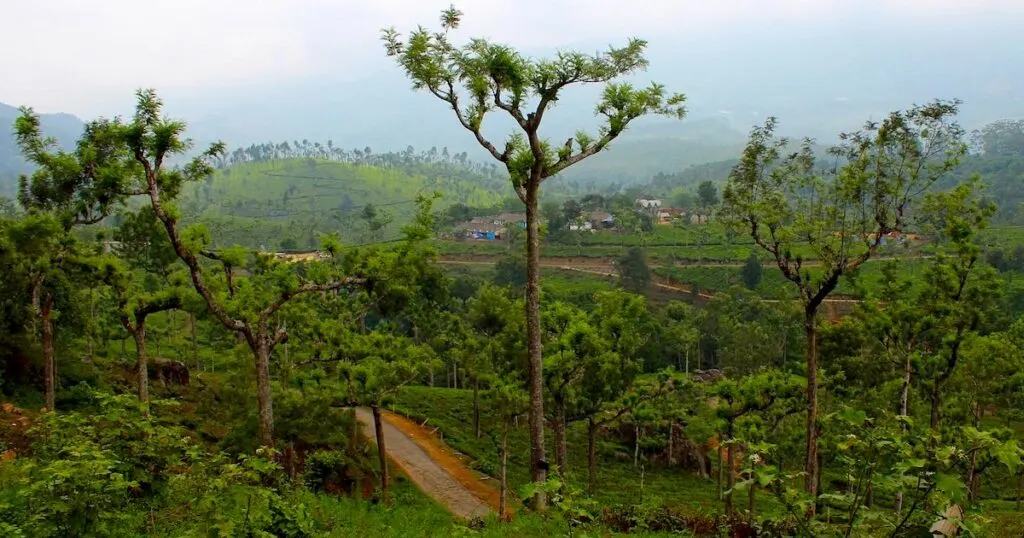
Munnar
Kerala is very large, so to get to north or south Kerala from Cochin, it’s best to take an additional flight.
Alternatively, if you want to visit the north or south first and work your way up or down Kerala, you can fly directly to Kannur or Kozhikode (for north Kerala) or Trivandrum (for south Kerala).
I think that central Kerala is the best place to begin your Kerala itinerary.
It’s very easy to navigate, and because it has a large influx of tourists, more people speak English.
If you want to gain confidence, start in central Kerala and then travel to north or south Kerala.
Flights! ✈️
Here’s why I use Skyscanner…
Finding a good deal on flights can often cut the cost of your trip in half. I use the ‘Whole Month‘ and ‘Price Alerts‘ tools to compare prices across different dates.
How Long Do You Need to Travel Kerala?
I recommend spending at least 1 – 2 weeks in Kerala
To explore central Kerala, you need at least one week. This is because Munnar and Thekkady are several hour’s drive from Kochi.
To explore south Kerala, you only need around three days, as Trivandrum and Kovalam are very close by.
Visiting Kollam in south Kerala will require an extra day or two, but if you’ve already visited the backwaters in Alleppey (in central Kerala), you can skip Kollam.
Finally, to explore north Kerala, you need at least five to six days in Kannur and Wayanad.
If you’re skipping Wayanad, you can quickly explore Kannur and Kozhikode in two to three days.
So, if you want to explore all of Kerala (central, north and south), your Kerala itinerary will need to be at least two to three weeks long. You can split it as follows:
- Central Kerala: 1 week + (best for tea plantations, wildlife, and backwaters)
- South Kerala: 3 – 5 days (best for beaches and Ayurveda)
- North Kerala: 5 – 6 days (best for culture, history, outdoor activities and wildlife)
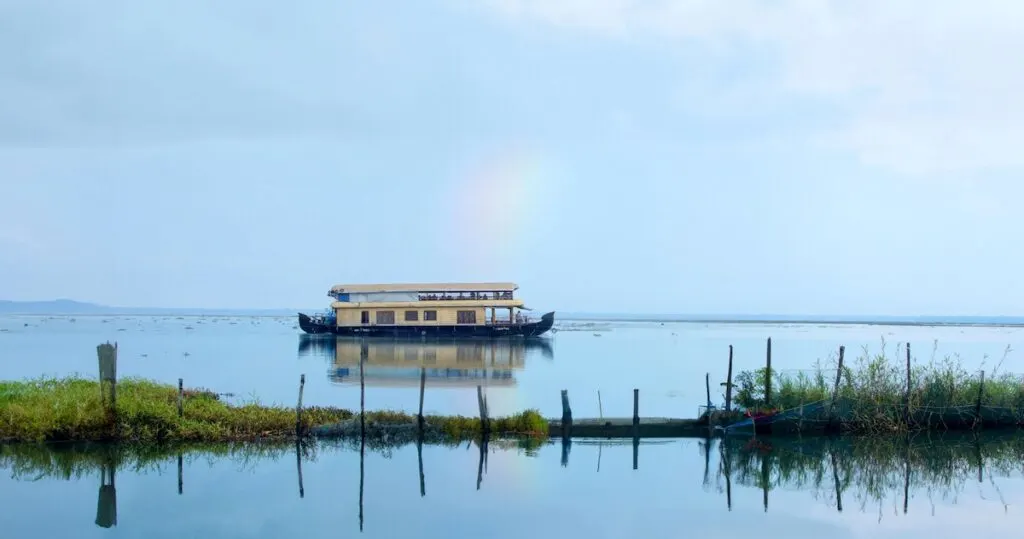
Kumarakom
The main thing to note is that if you are travelling to Kerala by public transport, the buses and trains are prone to delays.
If you have a very tight itinerary, you’re best off mainly travelling by private car and Uber.
How to Get Around Kerala
Getting around Kerala is the hard part. While you can use Uber in the cities, it’s trickier to reach remoter destinations (even popular destinations such as Munnar) without a driver.
1. Take Uber and taxis in cities
In the cities, you can use the Uber app to hail affordable taxis. Normal car taxis are also available on the street, although they are usually more expensive than Uber.
Tuk-tuks are also inexpensive; negotiate the price directly with the driver.
2. Book transfers to remote areas
Travelling from the city to remote areas (e.g. from Kochi to Munnar) requires a private driver, a transfer service or a group tour.
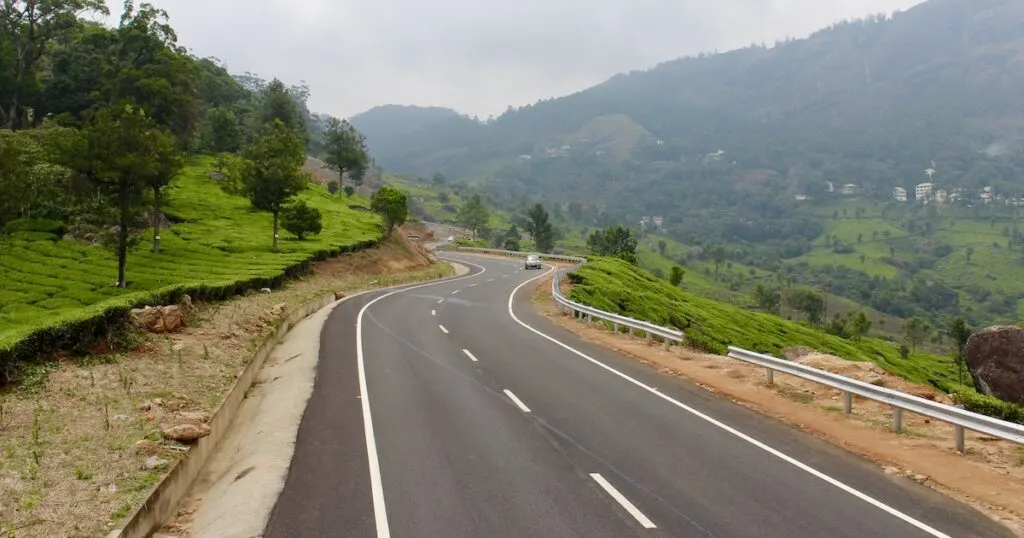
The same applies if you are staying in a remote area such as Munnar and want to reach an attraction (such as a tea plantation).
Local bus services are limited, so you will need to rely on taxis or tour services to take you there.
How to book transfers: There are several hotel-to-hotel transfers available on 12Go.
Alternatively, you can ask your hotel/hostel for assistance.
How to book tours: There are day tours on GetYourGuide and Viator.
However, they are limited in some destinations so often hotels/hostels can arrange a tour for you.
3. Brave the local buses and trains
Local buses are an affordable way to travel. However, they have limited bus stops.
They are also known for being quite basic facilities-wise.
You should be prepared for quite the adventure (and limited comfort) if you go down this avenue.
Finding the bus timetables can be difficult, so you will need to rely heavily on your hotel or hostel to assist you. Hostels will probably be more helpful, because they’re used to catering to budget travellers.
4. Take a multi-day tour instead
Many people take up the opportunity to join a multi-day tour in Kerala.
Multi-day tours are a wonderful entry-level way to explore, as they help you avoid the stress of arranging your own transport and activities.
This is a good idea if you’re nervous about your trip or travelling solo.
I checked Viator and they have a great selection of multi-day Kerala tours spanning over 5+ days.
Places to Visit in Kerala
Let’s jump into the many incredible destinations in Kerala – and why you might want to go to them.
This is by no means an exhaustive list, as Kerala is so big. However, these are some of the spots that I think should be worthy of your consideration (including a few offbeat options to get off the beaten track!)
Central Kerala
1. Kochi (Cochin)
Best for: Sightseeing and cultural experiences
Time needed: 1 – 2 days
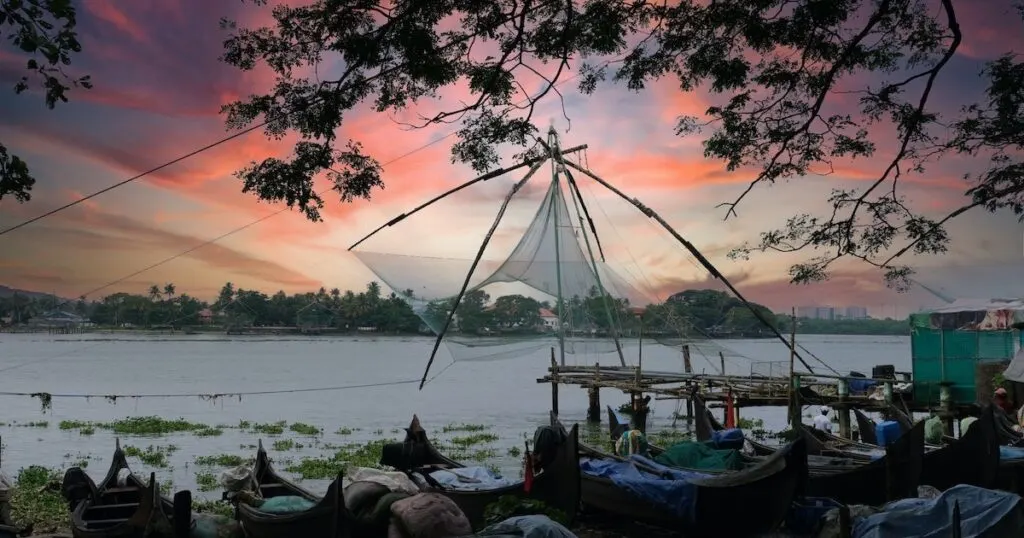
What’s a trip without some sightseeing? Kochi is one of the most interesting cities I have visited in a while, as it has influences from China, Europe and Arab countries.
The best example of this is Fort Kochi, the city’s old quarter.
It has Dutch and Portuguese colonial architecture, as well as traditional Chinese fishing nets.

Chinese fishing nets in Kochi
While in Kochi, you can visit the spice market, historic landmarks and museums.
There are also Ayurveda treatment centres where you can try treatments from India’s holistic medicinal practice.
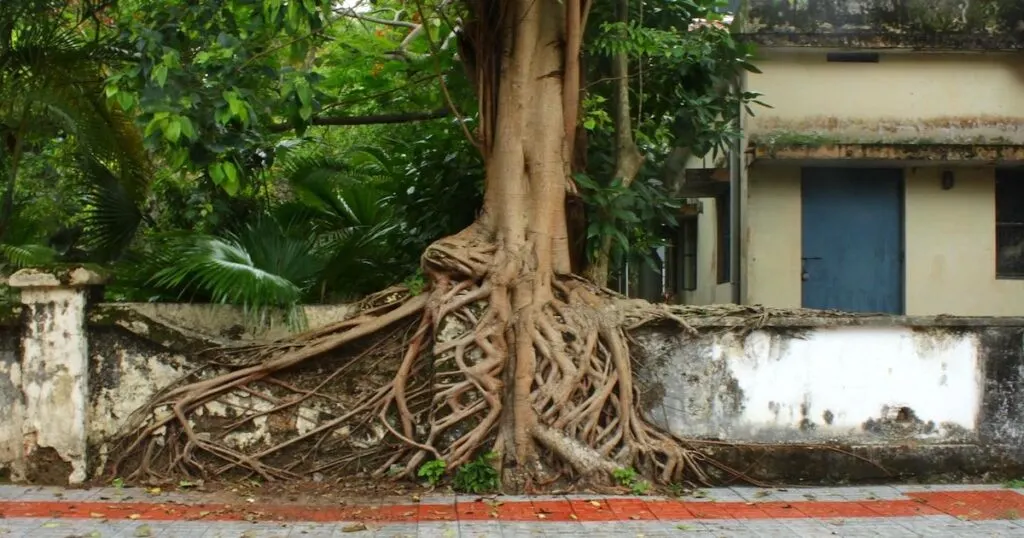
Kochi is a nice place to take a tuk-tuk tour, as it’s not always easy to reach everything on foot – especially when it’s hot and humid outside.
I stayed at Forte Kochi, a heritage hotel set in a colonial-style villa. It is right within walking distance of the Chinese Fishing Nets, so I had an endless amount of restaurants and attractions at my fingertips.
Where to Stay in Kochi
2. Alleppey (Alappuzha)
Best for: Houseboat and backwater cruises
Time needed: 1 – 3 days

Alleppey (short for Alappuzha) is best known for its houseboat and backwater cruises.
As I explain in my detailed Alleppey itinerary, It is only an hour and a half’s drive from Kochi, making it incredibly easy to visit in one day or to stay overnight.
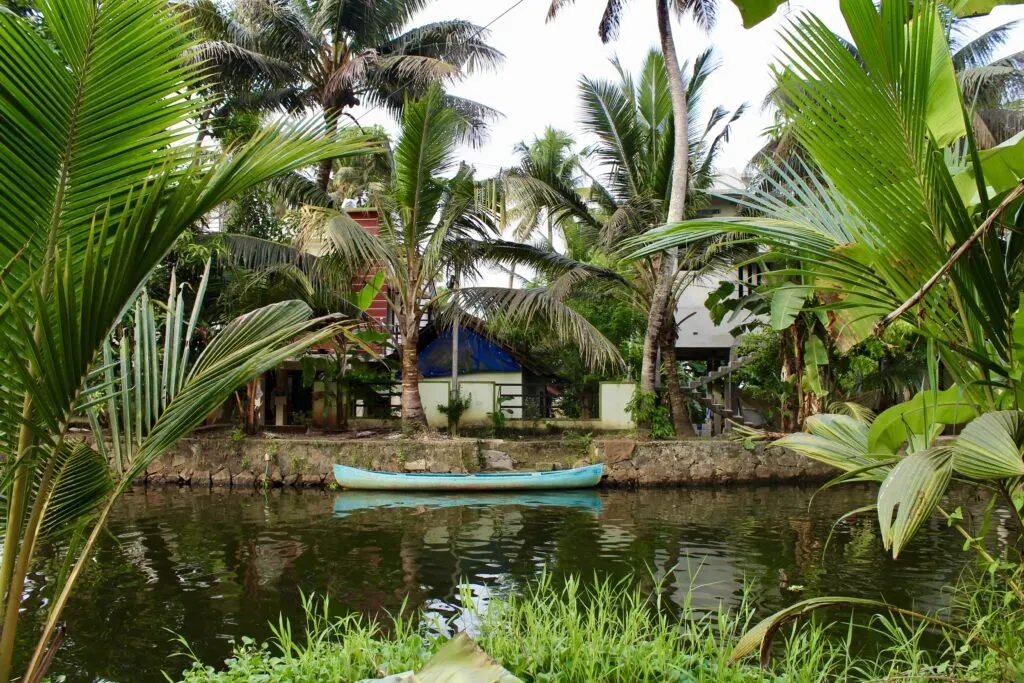
To get there, you can take the train from Aluva railway station. I took an Uber instead, as I was in a hurry.
If you are driving, you might want to break up the journey by visiting the International Coir Museum.
Coir weaving is one of Alleppey’s main industries, so it’s a good introduction to the area.
The most famous activity in Alleppey is the houseboat cruise.
The modern-day houseboat is based on the Kettuvallam, traditional boats that were used to transport rice and spices across Kerala.
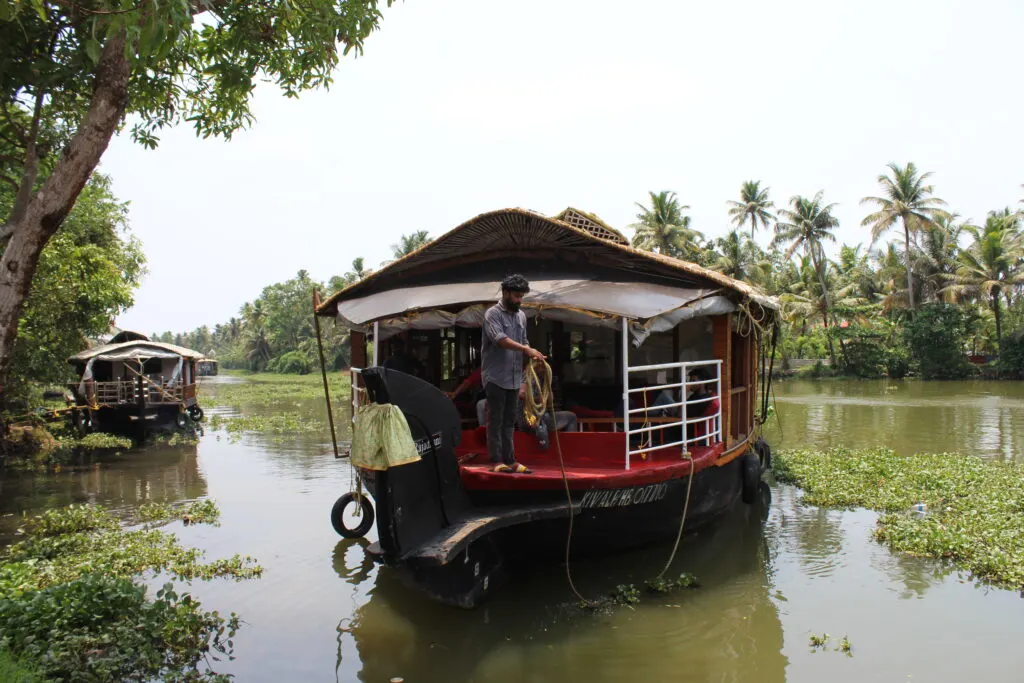
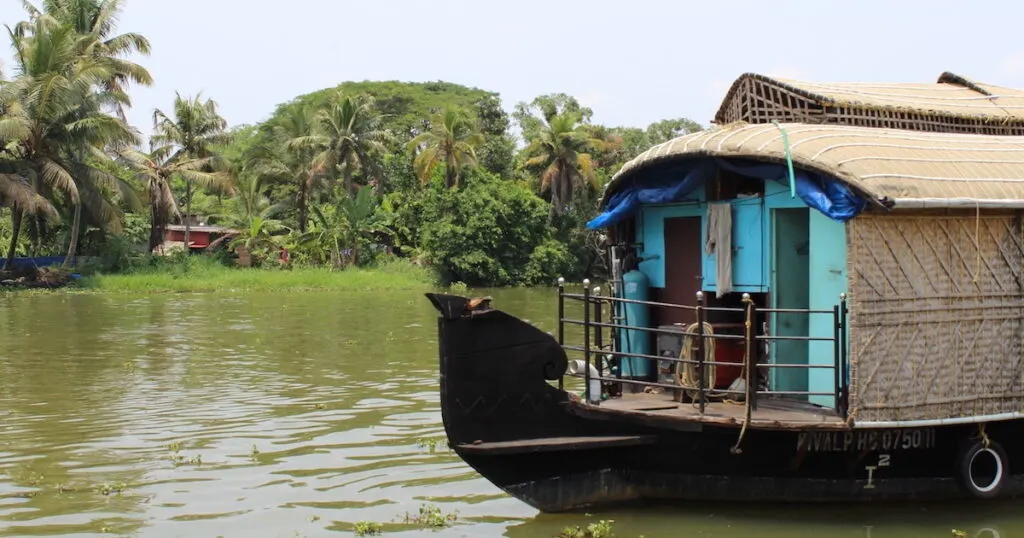
Houseboats in Kerala
To take a houseboat cruise, you can either find a tour on GetYourGuide or visit the DTPC Houseboat Pre-paid Counter to book a houseboat.
If you’re travelling during high season and short on time, it’s safer to do the former.
This overnight houseboat cruise from Kochi also includes pick-up and drop-off from the city, so you don’t need to arrange a train ticket or Uber.
Alleppey Beach is quite famous, as it has an old pier and lighthouse.
However, don’t miss out on the small villages around Alleppey, as they are very scenic.
One of these is Mararikulam, a traditional fishing village with a long, sandy beach.
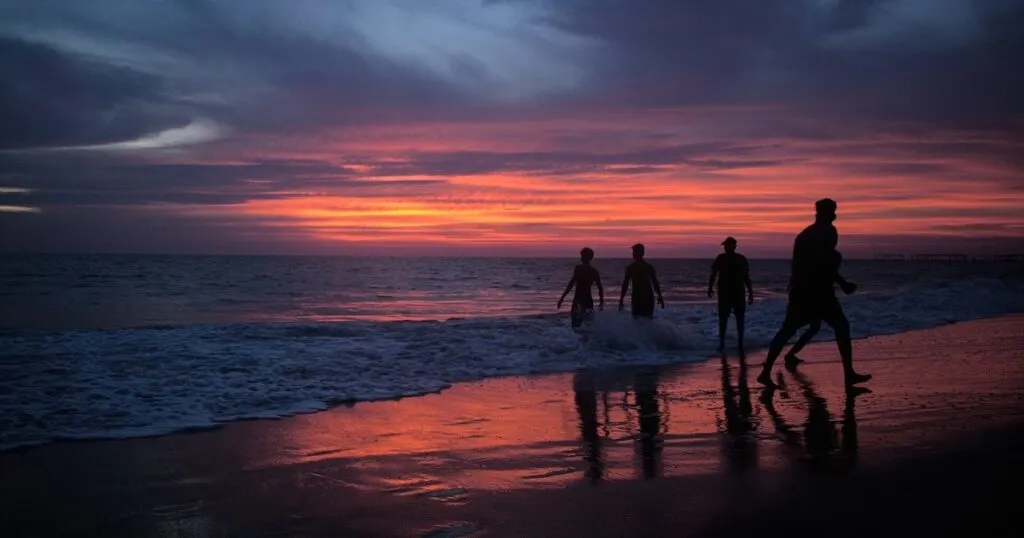
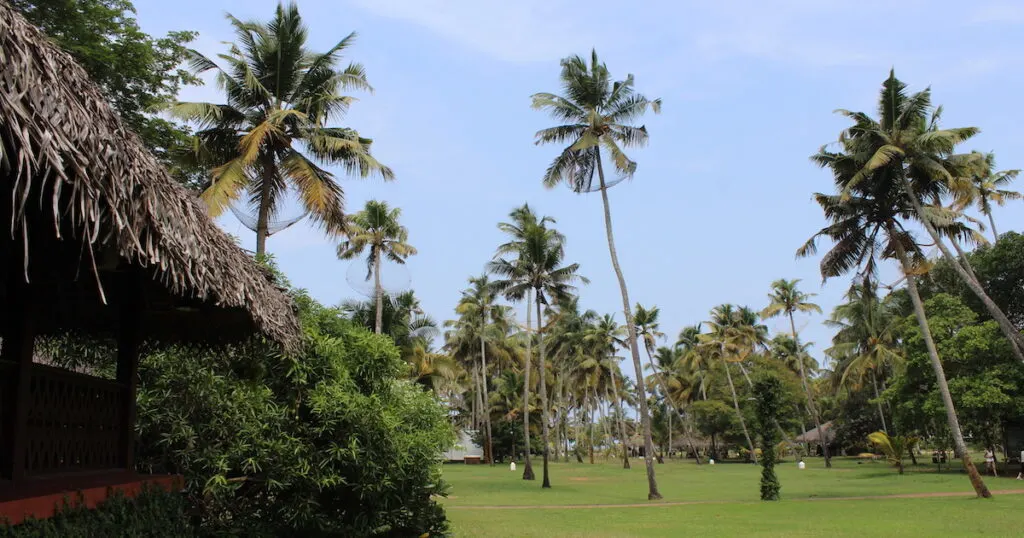
Marari Beach Resort (CGH Earth)
I stayed at Marari Beach Resort (CGH Earth) while exploring Alleppey.
This is a nice option if you fancy having direct access to the beach but staying within a short drive of the backwaters.
Alternatively, if you want to skip the beaches, you can stay directly on a houseboat.
Where to Stay in Alleppey
3. Kumarakom
Best for: Luxury backwater resorts and birdwatching
Time needed: 1 – 2 days

Kumarakom is next-door to Alleppey. It’s on the other side of Vembanad Lake, a popular place for birdwatching.
Kumarkom is most famous for its luxurious backwater resorts.
I stayed at Kumarakom Lake Resort, perhaps the most famous of all. Spread across 25 acres, its heritage villas are on the shore of the lake. The hotel also runs a daily lake cruise.
If you don’t want to stay at a resort, you can easily take a day trip to Kumarakom from Alleppey.
The Kumarakom Bird Sanctuary features species such as Siberian storks and cuckoos.
Boat cruises on the lake also provide a good chance to see migratory birds.
There are lots of boat tour operators in the centre of Kumarakom. You can walk around and ask for availability and prices.
Kumarakom also has the Travancore Heritage Museum, which displays antiques from the local area.
Where to Stay in Kumarakom
4. Munnar
Best for: Tea plantations and outdoor activities
Time needed: 2 – 4 days
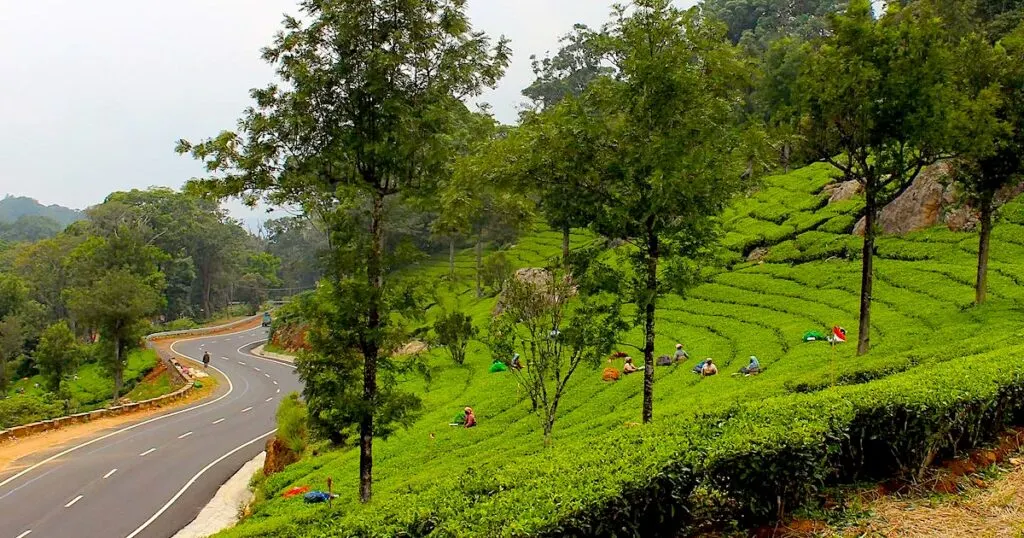
Munnar is my favourite part of Kerala. Funnily enough, my favourite moments are just from driving around the roads around Munnar’s tea plantations and jumping out of the van as soon as we saw a photo-worthy view.
The tea pickers work hard to collect tea leaves all day, even during the midday heat. The tiered plantations practically coat the hills in green.
As I explain in my detailed Munnar itinerary, Munnar’s tea plantations were set up by the British in the late 1800s, so the area also has a long and interesting history.
The one must-do activity in Munnar is to take a tea trek through one of the plantations. This is a time to learn more about the different types of tea cultivated in Munnar and take pictures.
Munnar has more than 50 tea plantations, but I recommend visiting one with views of the Lakshmi Hills, as this is an especially scenic part of Munnar.
This private tea trek offers Lakshmi Hills views. It also includes pick-up from your hotel by jeep.
As I explain in my detailed Munnar itinerary, Munnar is also a good place to watch one of Kerala’s traditional art forms, Kathakali.
Kathakali is a dance drama that communicates traditional Hindu stories using expressive techniques such as eye dancing.
Punarjani Traditional Village runs Kathakali performances every evening (during the high season). Tickets can be booked in advance on their website.
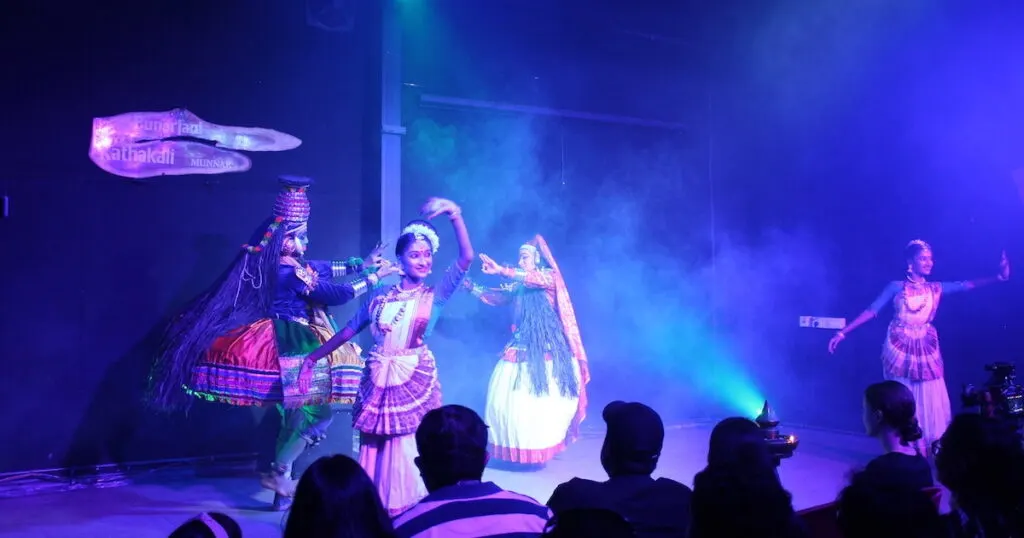
A Kathakali performance at Punarjani Traditional Village
From Munnar, you can also visit Eravikulam National Park.
I didn’t get a chance to go there, but it’s one of the best places in Kerala to spot Nilgiri tahr, an endangered horned mountain goat species.
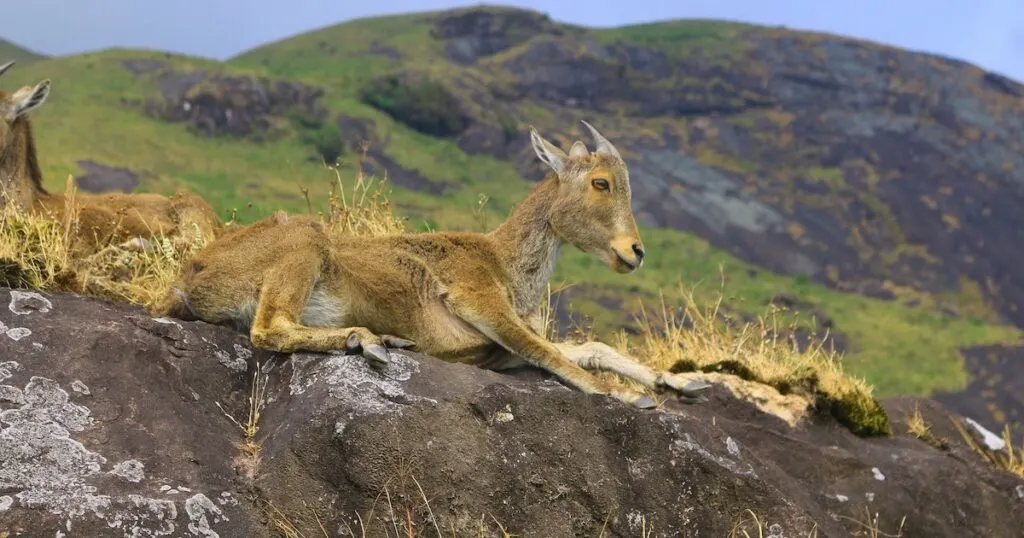
Nilgiri tahr
Other popular activities in Munnar include bamboo rafting on Periyar Lake, trekking at the Top Station, and activities such as village visits and tea tastings.
How to get to Munnar
It’s complicated to explore Munnar by public transport. You can take a local bus there, but to reach tea plantations your hotel will usually require a car.
It takes around 4 to 5 hours to reach Munnar from Kochi.
On 12Go, you can also book a private Kochi to Munnar transfer. Otherwise, you can co-ordinate a transfer directly with your hotel.
Where to Stay in Munnar
5. Thekkady
Best for: Wildlife watching
Time needed: 2 – 4 days
Located two to three hour’s drive from Munnar, Thekkady is excellent for outdoor activities and wildlife watching.
As I explain in my detailed Thekkady itinerary, I took a day trip to Cumbum Valley in Tamil Nadu, where I saw local farmers working in the fields and travelling by bullock carts.
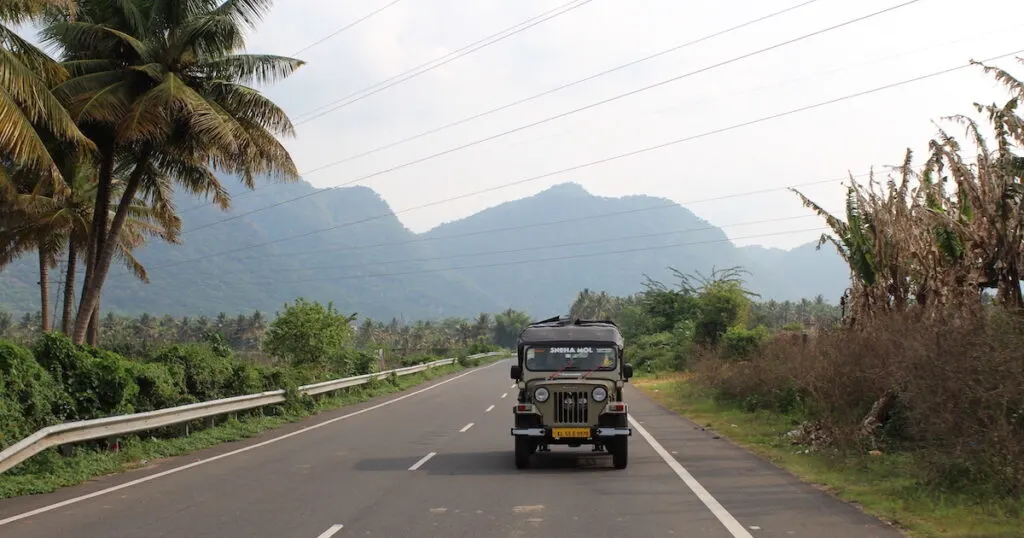
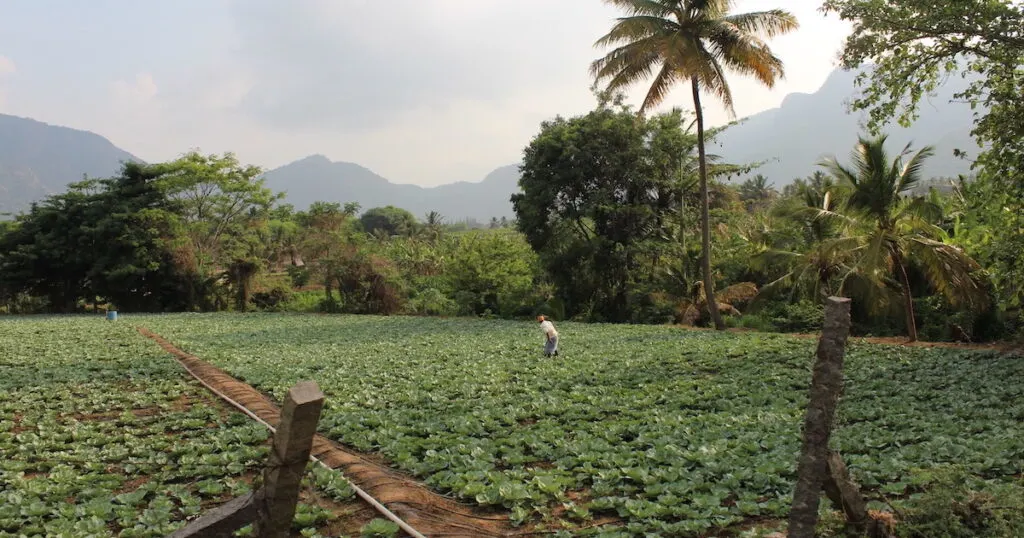
Cumbum Valley, Tamil Nadu
The main tourist activity in Thekkady, however, is to visit the Periyar Tiger Reserve.
On the Periyar Tiger Reserve website, you can reserve activities such as day treks, overnight treks, boating, tribal art performances and night treks.
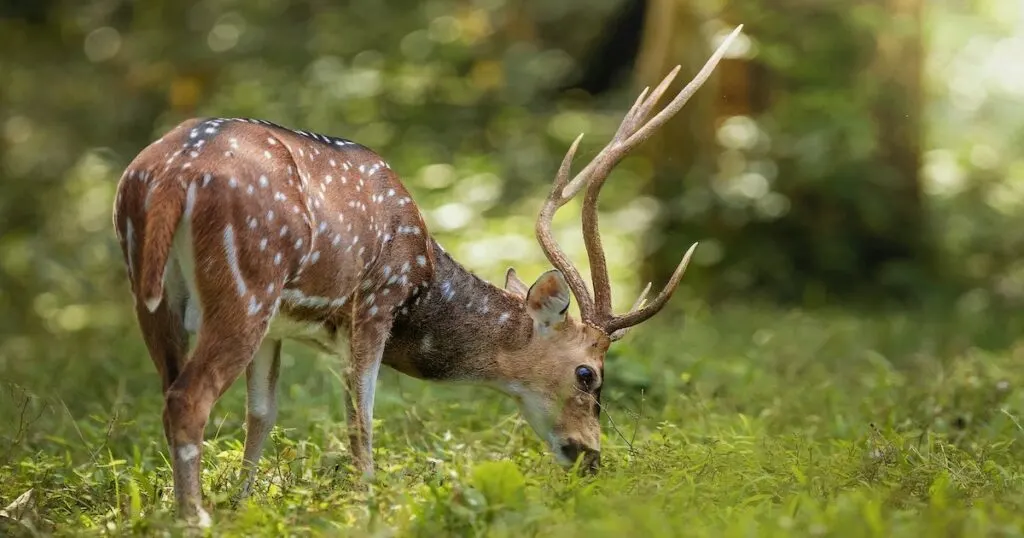
There are 76 species in the reserve, including Asian elephants, tigers, leopards and great Indian hornbills.
Where to Stay in Thekkady
North Kerala
1. Kannur
Best for: Theyyam rituals and Malabar cuisine
Time needed: 1 – 2 days

Kannur is located on the north Kerala coast. It’s packed with temples and forts, and an incredible place to try India’s famous Malabar cuisine.
In Kannur, you can watch the theyyam rituals from December to April. These ritual dances are performed to worship deities at temples across the city and surrounding towns.
Joining a Theyyam tour is a must, as it’s difficult to know where these live performances will be performed.
There are also lots of historic sites in Kannur. St Angelo Fort is a 16th-century fort that was used by colonial powers to control Kerala’s spice trade routes.
The Arakkal Museum is dedicated to the former Muslim royal family in Kerala.
The beaches around Kannuar are also beautiful, although there isn’t a swimming culture. They include Thottada Beach and Payyambalam Beach.
Where to Stay in Kannur
2. Wayanad
Best for: Outdoor activities and wildlife watching
Time needed: 2 – 4 days
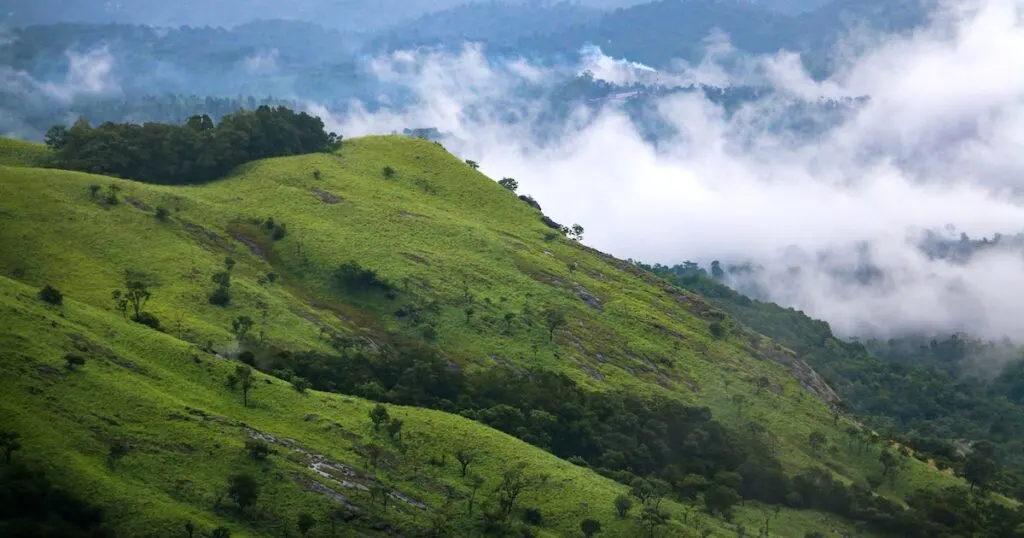
Wayanad is the most popular tourist destination in north Kerala. It’s loved by holidayers in India, as well as those from abroad.
The highland area is popular for its outdoor activities, coffee plantations and wildlife sanctuaries.
You can easily reach Vythiri (in Wayanad) by bus from Kozhikode.
The bus can be booked online via 12Go (Kozhikode to Wayanad).
There are many incredible highland resorts in Wayanad, including the Taj Wayanad Resort.
There are hostels in the Vythiri, Meppadi and Chundale areas.
For wildlife watching, the Wayanad Wildlife Sanctuary is the go-to. It has tigers, Asian elephants, and leopards.
On their website, you can book a jeep safari and several accommodation types (including dormitories).
Hiking Chembra Peak, a 2,100-metre mountain, is another popular activity.
Don’t forget to check out the Edakkal Caves and the Sree Thirunelli Mahavishnu Temple while you’re in Wayanad.
Where to Stay in Wayanad
3. Kozhikode (Calicut)
Best for: Backwater cruises and birdwatching
Time needed: 1 day
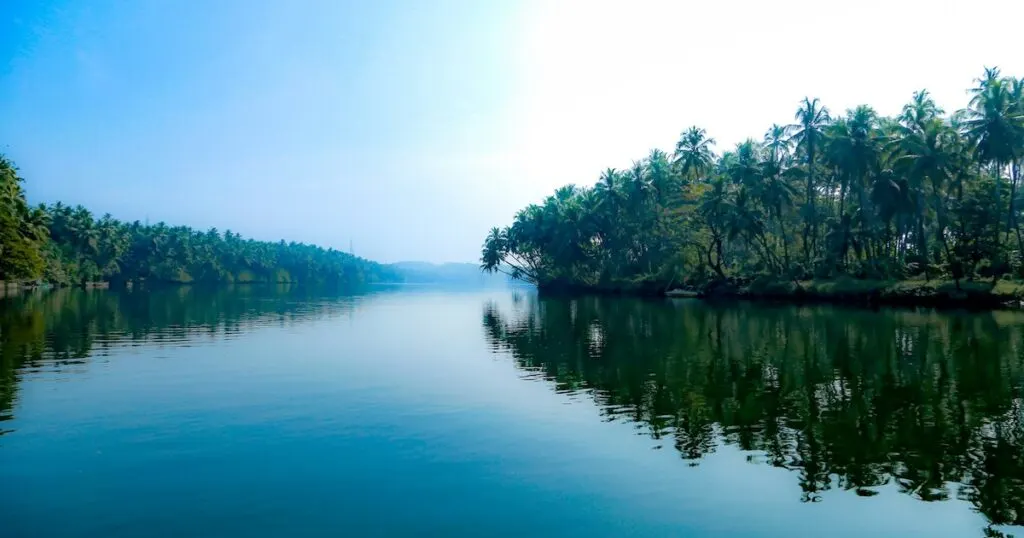
Kozhikode (also known as Calicut) is the most central point in north Kerala, as it has an international airport and good bus connections.
The city was also very important in Kerala’s spice trade, hence why it’s so well-connected.
Kozhikode is home to the Kadalundi Bird Sanctuary, a backwater area with migratory birds such as gulls, herons and turnstones. The best time to go birdwatching is between November and April.
The city is also near to backwaters, so if you missed Alleppey and Kumarakom in central Kerala, it offers a second chance at a houseboat or backwater cruise.
This Into the Mangroves tour will even help you to plant your own mangrove sapling.
Kappad Beach is also famous. It’s where the Portuguese arrived in 1498.
Where to Stay in Kozhikode (Calicut)
South Kerala
1. Trivandrum (Thiruvananthapuram)
Best for: Temples, museums and art galleries
Time needed: 1 – 2 days
Trivandrum (Thiruvananthapuram) is a good place to start your explorations in south Kerala, where the beaches and backwaters are the main focus.
This coastal city has British colonial architecture and stunning temples. A prime example is Sree Padmanabhaswamy Temple, a Hindu temple dedicated to Vishnu, with Kerala- and Dravidian-style architecture.

Sree Padmanabhaswamy Temple
Kuthira Malika Palace (built in British colonial style) keeps collections from the Travancore royal family, dating back to the 18th, 19th and 20th centuries.
You could take this half-day Trivandrum city tour to see locations such as the Napier Museum, Sri Chitra Art Gallery, Fort Trivandrum, Jew Town and the Ernakulam Shiva Temple.
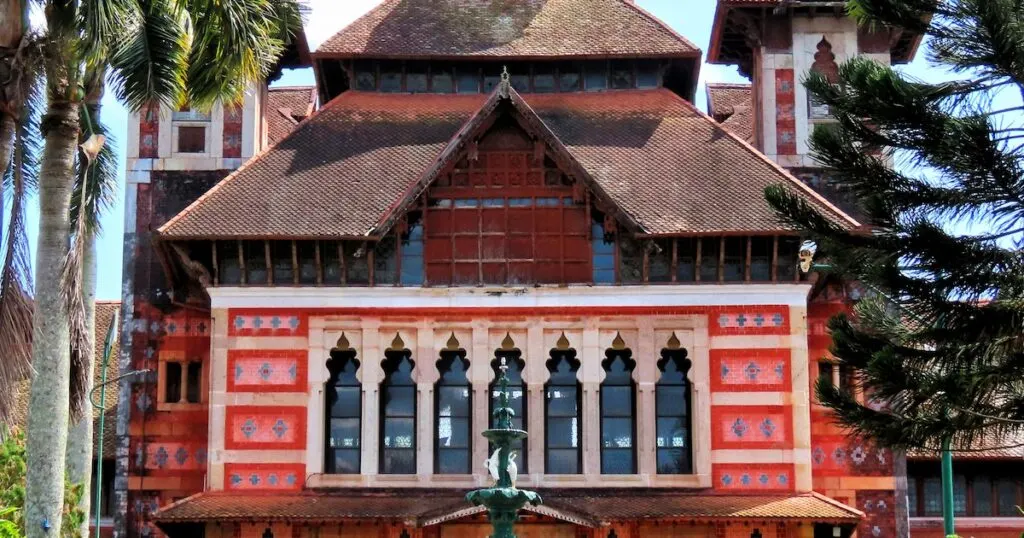
Napier Museum
You only really need one day in the city before you can move on to visiting the backwaters and beaches to the south of the city.
Where to Stay in Trivandrum
2. Kovalam
Best for: Beaches, seafood and arts and crafts
Time needed: 1 – 2 days
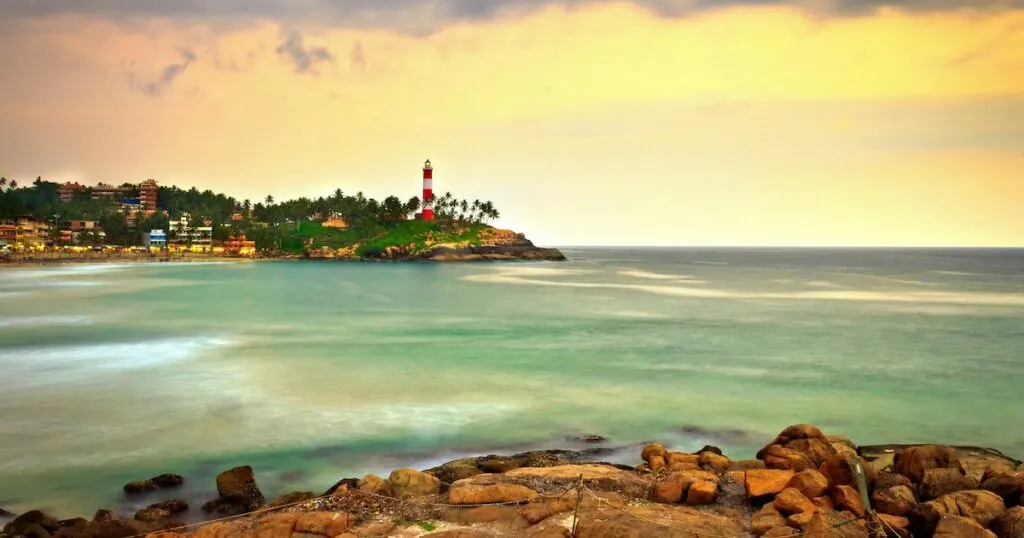
Kovalam is a must-visit if you want to experience the Kerala beach culture.
Plus, it’s only half an hour’s drive from Trivandrum, making it easy to get to by bus or Uber.
Kovalam’s most famous beach is Lighthouse Beach, where a red-and-white-striped lighthouse offers views over the bay.
However, Kovalam is also surrounded by wilder beaches backed by palm trees. Hawa Beach is the most famous.
The early morning is the best time to visit the Kovalam Fish Market, as this is when the fishermen assess their hauls.
It’s worth checking out the Kerala Arts & Crafts Village too, where you can see traditional handlooms and different weaving styles from around Kerala, as well as occasional cultural performances.
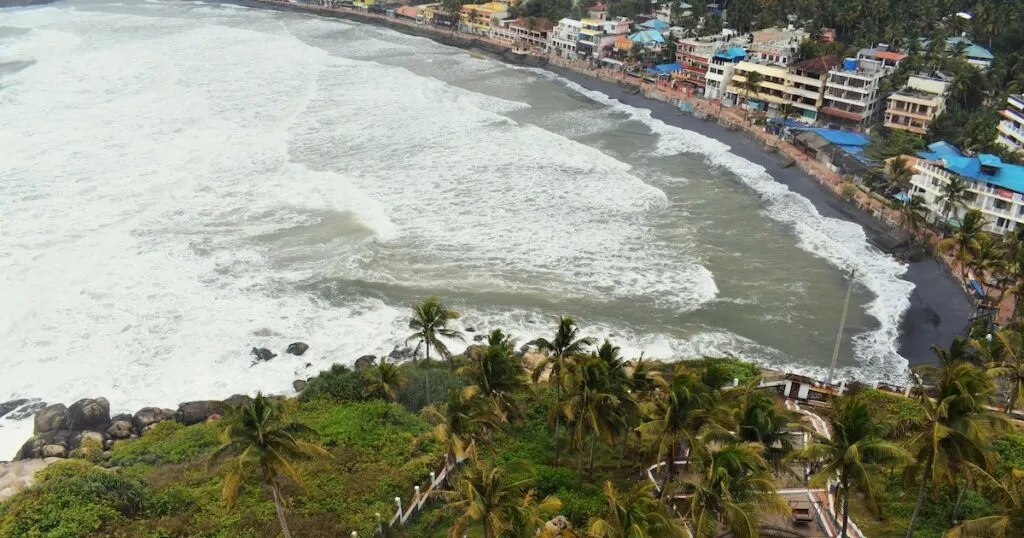
You should have no trouble finding somewhere to practise yoga in Kovalam either, as the beach town has a thriving arts and wellbeing scene. Ayurveda treatments are also popular here.
Where to Stay in Kovalam
3. Kollam
Best for: Backwater cruises and beaches
Time needed: 1 – 2 days
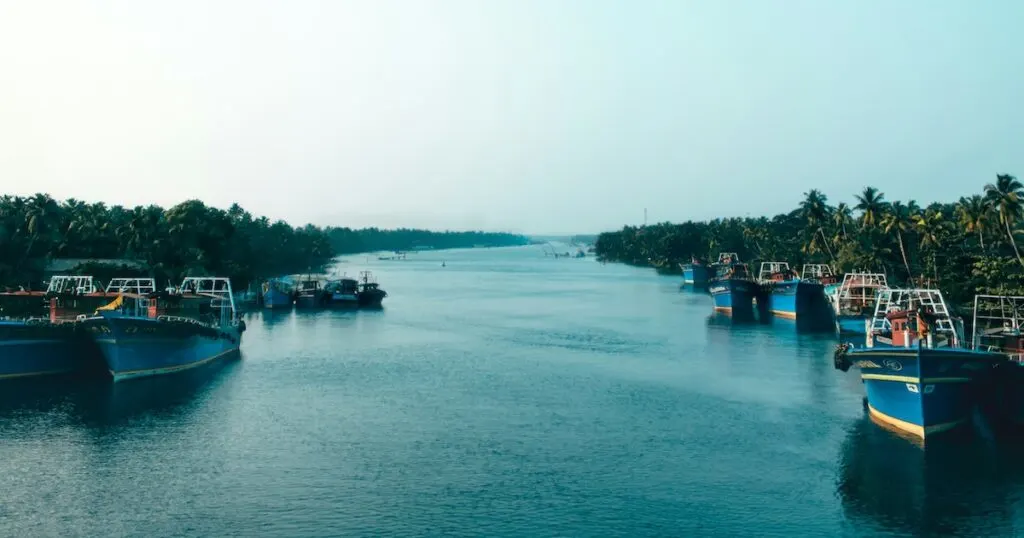
Located north of Trivandrum, Kollam is accessible by direct train from Trivandrum (taking one hour and 20 minutes).
If you haven’t already visited the backwaters in central or north Kerala, it’s a worthy addition to your trip.
Backwater cruises generally start by exploring Ashtamudi Lake, where there are over 50 different bird species.
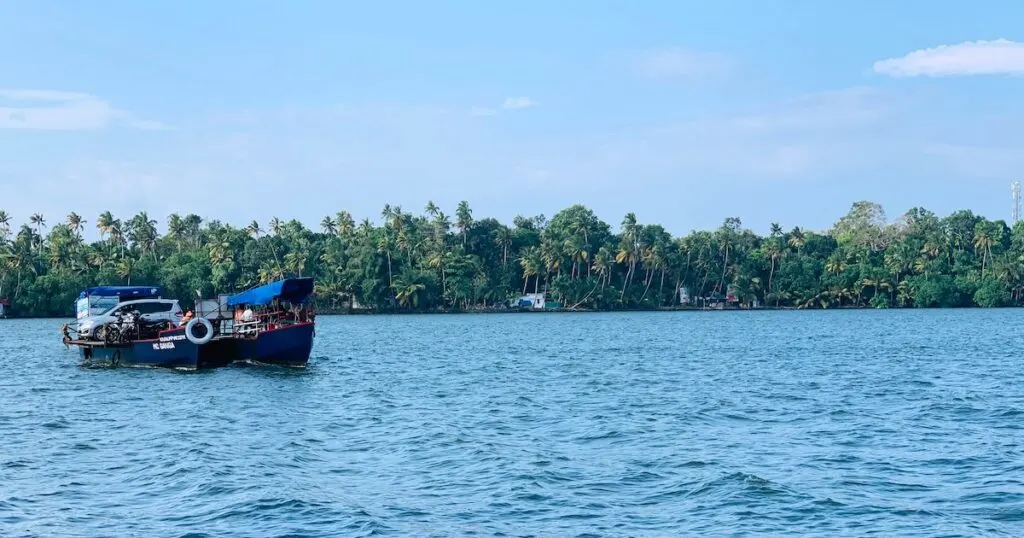
Kollam also has scenic beaches, including Kollam Beach and Thirumullavaram Beach. Thangassery Light House is one famous landmark.
From Kollam, you can also take a trip to the Kumbhavurutty Waterfalls.
Where to Stay in Kollam
5 Must-Do Things in Kerala
These are the five things must-do things that you should include in your Kerala itinerary. Many of these shape my happiest memories in Kerala.
1. Backwater or houseboat cruise
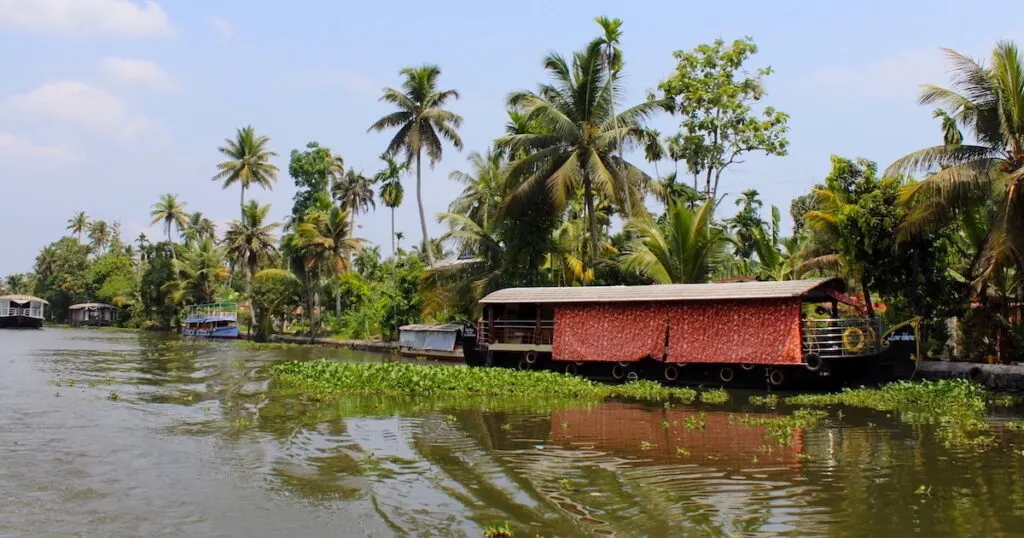
Kerala is synonymous with houseboat cruises. This style of houseboat cruise is only available in Kerala, as the houseboats are modelled off of the traditional kettuvallam boats that were used to transport spices and rice across the state.
Cruises can be a little pricey, so the second best thing to do is to take a standard backwater cruise.
Kerala’s backwaters contain a mixture of saltwater and freshwater, so they have a very distinct ecosystem. You may see kingfishers, monitor lizards, vipers, otters, dolphins and egrets.
There are backwaters in central, south and north Kerala. However, Alleppey has been nicknamed the ‘Venice of the East’ and Kumarakom is famous for its bird species – both of these are in central Kerala.
2. Visit a tea plantation
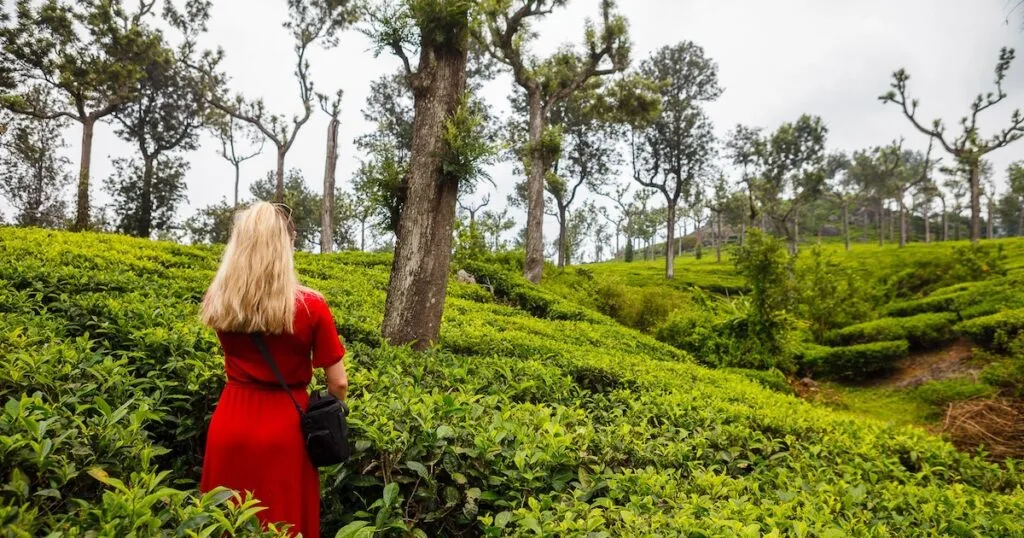
I’ve visited tea plantations in several places around Asia, but so far, Munnar is the most scenic.
Taking a tea trek is a great introduction to the history of tea cultivation in Munnar.
3. Experience an Ayurvedic treatment
Ayurveda is a traditional medicinal approach that has been used in India for thousands of years.
Kerala has many Ayurveda resorts which can provide a personalised Ayurvedic treatment plan.
Ayurveda tourism is huge in Kerala – it’s often called the ‘Land of Ayurveda’.
Ayurveda is a whole-body science, so staying at a resort is the best way to get a sense for the practice. If you’re short on time though, a one-off ayurvedic massage is still a good entry.
The Abhayanga massage uses herbal oils. The Shirodhara treatment is also famous – herbal oils are applied over the head to improve sleep and help you relax.
Some of the most popular Ayurveda resorts in Kerala include Nikki’s Nest (Trivandrum) and The Kairali (Kannur).
4. Try Sadya, the traditional Kerala platter
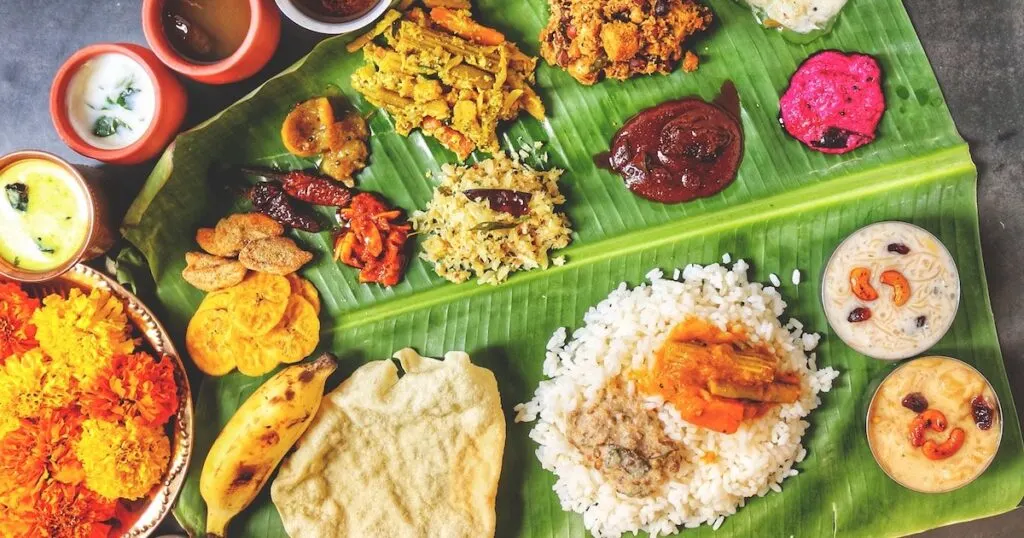
Many restaurants serve Kerala’s traditional platter, Sadya.
Sadya is a traditional meal that is served on a banana leaf. One by one, you are provided with rice, bananas and a variety of vegetarian dishes (sometimes up to 24–28 different dishes) such as sambar and parippu.
It’s delicious and culturally significant. It originated in Kerala as a celebratory feast for Vishu and Onam.
5. Watch Kathakali and Kalaripayattu
Don’t leave Kerala without watching at least one of its traditional art forms.
Kathakali is a traditional dance drama which tells Indian epic stories (usually Ramayana). It uses a combination of dance, acting and eye dancing to tell the story – not words.

Kathakali was traditionally performed in royal courts.
Kalaripayattu is another traditional art form in Kerala. The martial arts originated in Kerala in the 11th to 12th centuries.
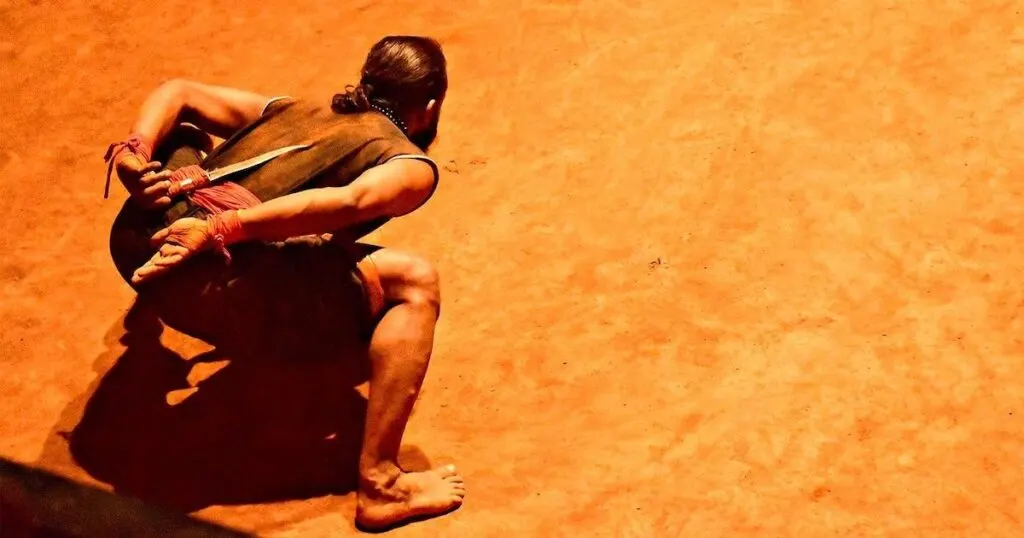
As it uses combat weapons such as swords, spears and staffs, kalaripayattu was once banned by the British.
I watched Kathakali and a brief kalaripayattu performance at Punarjani Traditional Village in Munnar.
Kerala Itinerary for 5 Days to 2 Weeks
Still scratching your head over how long to spend in each place, and which place to prioritise?
Here’s your chance to steal my itinerary – as someone who has already taken their Kerala trip, this is what I’d do if I had the chance to return on a strict timescale.
5-Day Kerala Itinerary
If you only have five days to spend in Kerala, I would focus on central Kerala.
- Day 1: Arrive in Cochin and take a Kochi to Munnar transfer immediately.
- Day 2: After staying overnight in Munnar, take a tea trek and then spend the evening watching Kathakali at Punarjani Traditional Village.
- Day 3: Organise a private driver to take you back to Kochi early in the morning. Explore Fort Kochi on a tuk-tuk tour and try a traditional Ayurvedic treatment in the evening.
- Day 4: Take an overnight houseboat cruise in Alleppey, including pick-up and drop-off in Kochi.
- Day 5: Finish your houseboat cruise and return to Kochi to explore the spice markets and eat Sadya, a traditional platter.
7-Day Kerala Itinerary
With seven days in Kerala, you can explore the entirety of central Kerala (Kochi, Alleppey, Munnar and Thekaddy).
A) Follow the five-day itinerary above and add on a visit to the Periyar Tiger Reserve.
B) Replace the Periyar Tiger Reserve with a brief visit to Kannur (to take a theyyam rituals tour) or south Kerala (for beaches).
Two-Week Kerala Itinerary
This rough two-week Kerala trip itinerary should give you an idea of how you can plan your trip.
Just remember, it’s better to leave some leeway for any transport delays, so you may want to remove one or two of these activities.
- Day 1: Arrive in Cochin and take a Kochi to Munnar transfer.
- Day 2: Take a tea trek and watch Kathakali at Punarjani Traditional Village.
- Day 3: Organise a private driver to Thekkady to visit the Periyar Tiger Reserve.
- Day 4: Continue trekking at the Periyar Tiger Reserve.
- Day 5: Travel back to Kochi. Explore Fort Kochi on a tuk-tuk tour.
- Day 6: Take an overnight houseboat cruise in Alleppey.
- Day 7: Return to Kochi.
- Day 8: Take a flight to Kozhikode in north Kerala and explore the city.
- Day 9: Travel to Wayanad and visit a coffee plantation.
- Day 10: Spend the day in Wayanad, trekking, wildlife watching or visiting waterfalls and temples.
- Day 11: Travel to Kannur.
- Day 12: Take a theyyam tour in Kannur.
- Day 13: Fly to Trivandrum in south Kerala and explore the temples and historic sites.
- Day 14: Visit Kovalam’s beaches, before ending your trip.
Extra Tips for Visiting Kerala

1. Download some useful apps
- Google Translate: Malayalam is the official language in Kerala, but people in Kerala speak a variety of languages. including Tamil, Tulu, Kannada, Gujarati and English.
- Google Maps or Maps.me: These two apps are helpful for navigation.
- Currency conversion app: A currency conversion app will help you to get an idea of how much things cost.
- Uber
2. Get a SIM card
Wi-Fi is readily available in most hotels, restaurants, and cafes. However, that’s not always the case in rural destinations.
You can buy a physical SIM card at the airport. Otherwise, Airalo offers an affordable India eSIM for 7, 15 or 30 days.
I hope you found my itinerary for Kerala useful! Enjoy your trip – or if you want more information, continue reading…
Suggested reading:
- What to wear in Kerala + free packing list!
- Munnar itinerary – things to do in Munnar
- Alleppey itinerary – backwaters, houseboats and more.
- Steal my Thekkady itinerary

